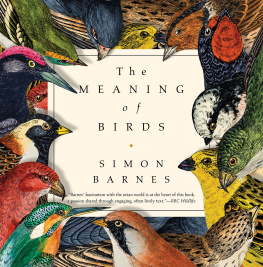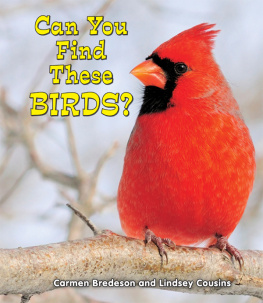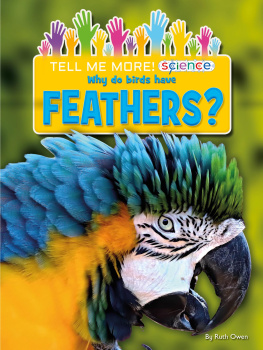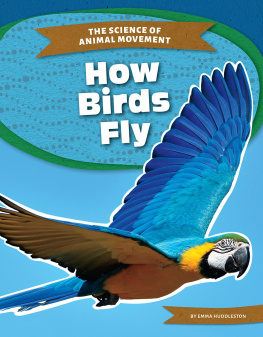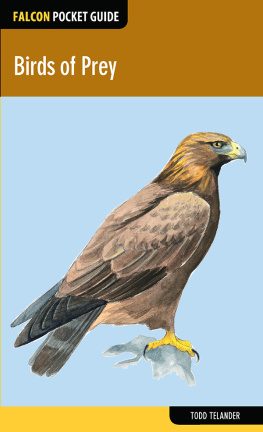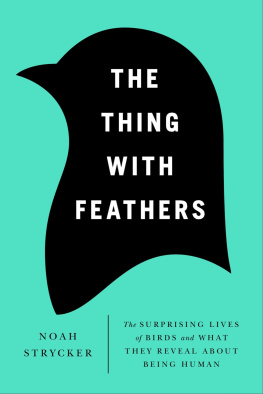
This ones for JB, Viv and the World Land Trust with thanks for swallow-tailed hummingbirds, rhinoceros-billed hornbills and lammergeiers (but dont mention the jaguar)
F light has immense meaning for us humans because we cant do it. Instead we live in a dream of flight, and flight envy is part of the human condition. Thats why birds, more than any other group of living things, draw us into the world beyond humanity.
Go to the church of the Holy Trinity at Blythburgh in Suffolk. It stands on a small eminence surrounded by marshland. The estuary of the River Blyth stretches out before it, underneath the vast East Anglian sky. Inevitably its a fabulous place for birds. You can birdwatch in the churchyard, picking up the flamboyant avocets and the stately, cruising marsh harriers. You can hear the sharp calls of redshank, curlew and oystercatcher, so that it sounds as if the marsh itself is singing to you.
Then step inside the church and raise your eyes to heaven; there you will see a flight of twelve angels soaring above you. Angels are the holiest beings in Christianity: second only to God in their sanctity. So what do we do to make them special? We give them wings.
Now look more closely at the wings that cleave to the lofty ceiling of the church and you will see that these angels are flying with the wings of marsh harriers. Across the centuries marsh harriers have lived around Blythburgh. They are birds of prey, and they are capable of flying at an uncannily low speed. They hunt by quartering the waterways and reed beds for water voles, moorhens and frogs, and their technique is to do so very, very slowly, inspecting the ground below them with meticulous attention. Flying slowly without falling out of the sky is one of the hardest tricks a flying animal or a flying machine can pull off, but marsh harriers are masters. They are improbably buoyant. They fly as if they are not really at one with the earth beneath. Occasionally, and with great reluctance, they come down with the action of a shuttlecock in slow motion. They touch the base earth as if they werent quite sure of their welcome. The same earth-rejecting airiness can be found outside on the marsh and inside on the roof of the church.
And in both cases the power of flight touches the human soul.
All human mythologies are filled with flying creatures. The stories we use to explain our world and our place within it are packed with flight. Every time humans sought to express something special, magical and full of meaning, the idea grew wings. Every culture on earth brings us creatures that waged war on gravity and won: Chinese dragons can fly without the need for wings, and they bring good luck to all those worthy of it. The thunderbird of the indigenous people of North America is not a puppet but a great bird whose wingbeats make the sound of thunder. Garuda flies through Hindu and Buddhist mythologies. Quetzalcoatl is the feathered serpent of Central and South America. The rainbow serpenta snake that arcs across the skyis a major figure in the mythology of Australian Aboriginal people.
The West is as full of flying myths as any other part of the world: fairies, our own dragons, harpies, hippogriffs, witches, the phoenix, the sphinx and Pegasus. We still make myths around the same theme: Superman is defined by his ability to fly: Harry Potter was the best flier at Hogwarts: Narnia acquired its magical protecting apple tree with the help of a boy: a girl and a flying horse called Fledge.
The Wests essential flying story is that of Daedalus, who made wings and flew, and so was able to escape from King Minos of Crete. His name was borrowed by James Joyce for his fictional self, Stephen Dedalus, who flew by the nets that were set out to trap him. But Daedaluss son Icarus is the one we remember: the boy who flew too close to the sun. The wax that held his wings together melted and down he came: a tiny splash in the painting traditionally attributed to Pieter Bruegel the Elder, Landscape with the Fall of Icarus. It was commemorated by the poet William Carlos Williams as:
The Icarus legend is about the eternal collision of human limitations and human ambitions

a splash quite unnoticed
this was
Icarus drowning
The Icarus legend is about the eternal collision of human limitations and human ambitions. The flight ambition is expressed in most of the games we play. All the non-confrontational sports are about flight, or at least the defiance of gravity. With long jump, high jump, pole vault and gymnastics we seek to fly, however briefly, under our own power. Winter sports give us the illusion of flight in the freedom from friction as we slip, slither and slide with skis and skates and sleds. In the horsey sports we borrow wings from another being: for every rider, every horse is Pegasus.
Flight isnt just a quick way of getting from A to B or a more efficient way of getting the groceries. Its an escape from the human condition, an abandonment of the cares of daily life: an entry into the world of good dreams in which you float effortlessly across oceans. Freud was mad about flying dreams:
Do not feel disturbed because the dreams of flying, often so beautiful, and which we all have had, must be interpreted as dreams of general sexual excitement, as erection dreams... It is no objection to this conclusion that women may have the same dreams of flying.
Many drugs are associated with flight. Try Timothy Leary and The Politics of Ecstasy, Aldous Huxley and The Doors of Perception, The Teachings of Don Juan: A Yaqui Way of Knowledge by Carlos Castaneda: all books that affirm the desirability of mental flight. They seek to break down the barrier between objective and subjective realities, so that the question of whether a person really flew becomes not only irrelevant but also meaningless. Like all the other ways of seeking flight, hallucinogenic drugs are about the search for an uncommon freedom. Mike Heron of the Incredible String Band summed this up in his 1966 song Footsteps of the Heron, in which he stresses the uniportance of money, apart from the fact that the stuff enables him to buy wings to fly, cause without them the sun aint so sunny.
Sex, religion, sport, spiritual exaltation, drugs, wish-fulfilment dreams, hope, ambition: all these things are tied up with flight. We took the idea from the birds, and always the idea leads us back to the birds.
Most ground-dwelling mammals have roughly the same vocabulary of movement. Horses show this most clearly: a walk has four beats, a trot has two, a canter has three beats and a gallop brings us back to four again. But there are all kinds of combinations and blurrings of the boundaries, as you see when you watch horses messing about in a field.
The vocabulary for flight looks pretty limited on the face of it. Roughly speaking, there are four ways to fly: powered flight, like a passenger jet or a blackbird barrelling away from you with a rattling alarm call; gliding with still wings, like a glider or a gull crossing a beach; soaringthat is to say, gaining height with still wingswhich can be done by a glider and rather more efficiently by a vulture; and hovering, like a helicopter or a kestrel.
But there are many ways in which these classifications blur into each other and are used in different ways or in combination. So lets look at some of the champions of flight.
The fastest bird in the world is the peregrine. This is a falcon that has taken to the city centres of Britain in recent years. They can be found nesting on the spire at Norwich Cathedral and cruising down the Thames with the dome of St Pauls as a backdrop. They are birds that feed on other birds; and birdssince they can flyare by definition a difficult target. Overcoming that difficulty is the peregrines speciality, and speed is his solution.
Next page
